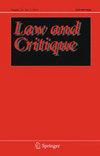The Robot and Human Futures: Visualising Autonomy in Law and Science Fiction
IF 0.8
Q2 LAW
引用次数: 0
Abstract
Abstract This article argues that legal discourses about robots are framed within a limiting ‘human paradigm.’ While this is not a specific failure of lawyers, it has significant consequences for law in a digital future. This visualising of robots has its origins in mainstream twentieth-century science fictional tropes of artificial beings. This article begins by identifying the predominant science fiction tropes regarding artificial beings as a source of anxiety for human futures, as located in discrete bodies and as separate from humans. The article then traces this ‘human paradigm’ in robot law scholarship. It is shown how a focus on embodiment and separation disrupts appreciation of the emerging partial disembodiment and hybridity of digital autonomy. There is a continual sense of needing to keep robots and humans distinct and separate, which is not how digital futures are manifesting.机器人和人类的未来:法律和科幻小说中的可视化自治
摘要本文认为,关于机器人的法律话语是在一个有限的“人类范式”框架内。“虽然这不是律师的具体失败,但它对数字化未来的法律产生了重大影响。”这种对机器人的可视化源于20世纪主流科幻小说中对人造生物的比喻。本文首先确定主要的科幻小说修辞,将人造生物视为人类未来焦虑的来源,因为它们位于独立的身体中,与人类分离。然后,文章在机器人法律研究中追溯了这种“人类范式”。它显示了对体现和分离的关注如何破坏了对新兴的部分分离和数字自治的混合性的欣赏。人们一直有一种需要将机器人和人类区分开来的感觉,而这并不是数字未来的表现方式。
本文章由计算机程序翻译,如有差异,请以英文原文为准。
求助全文
约1分钟内获得全文
求助全文
来源期刊

LAW AND CRITIQUE
LAW-
CiteScore
2.30
自引率
25.00%
发文量
19
期刊介绍:
Law and Critique is the prime international critical legal theory journal. It has been published for 20 years and is associated with the Critical Legal Conference. Law and Critique covers all aspects of legal theory, jurisprudence and substantive law that are approached from a critical perspective. Law and Critique has introduced into legal scholarship a variety of schools of thought, such as postmodernism; feminism; queer theory; critical race theory; literary approaches to law; psychoanalysis; law and the humanities; law and aesthetics and post-colonialism. Postmodern jurisprudence, law and aesthetics and law and psychoanalysis were pioneered in Law and Critique which remains the most authoritative international source for these schools of thought. Law and Critique is keen to translate and incorporate non-English critical legal thought. More specifically, Law and Critique encourages the submission of articles in the areas of critical legal theory and history, law and literature, law and psychoanalysis, feminist legal theory, critical race theory, law and post-colonialism; postmodern jurisprudence, law and aesthetics; legal phenomenology; and law and autopoiesis. Past special issues include: ''Critical Legal Education''; ''The Gender of Law''; ''Law and Postmodernism''; ''Law and Literature''; ''Law and Post-colonialism'', ''Law and Theatre''; ''Jean-Luc Nancy and Law''; ''Agamben and Law''. Law and Critique is ranked amongst the top 20 per cent of law journals by the Australian Research Council.
 求助内容:
求助内容: 应助结果提醒方式:
应助结果提醒方式:


